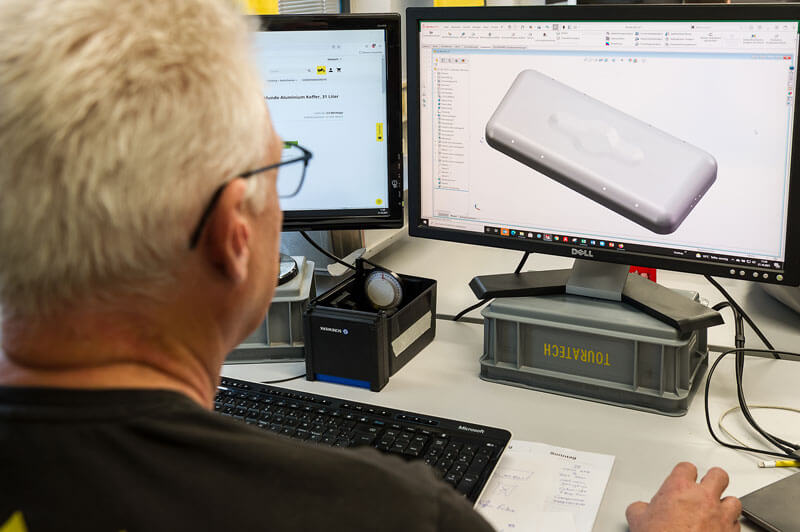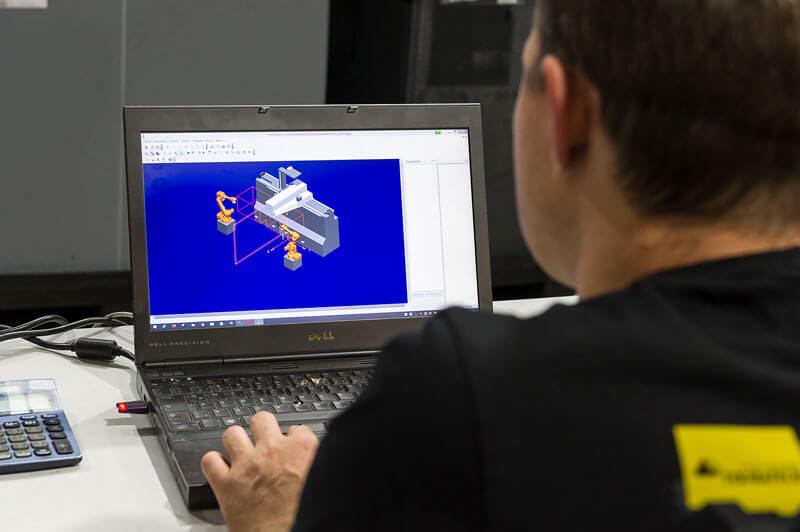The machining head circles the workpiece with movements that are as jagged as they are precise. Here a wide swivel, there a tiny circular movement. Accompanied by a hiss, a gossamer, bluish beam of light penetrates the aluminium sheet seemingly effortlessly. We are standing in front of a machining centre equipped with 3D lasers in Touratech's production.
When the machining head, which is not much bigger than a tin can, is back at its starting position, Marc Holder opens the doors of the machining centre. As a process engineer, Holder is entrusted with the continuous optimisation of all manufacturing processes at Touratech. The aluminium part turns out to be the lid of a ZEGA case. In less than one and a half minutes, the 3D laser has cut off the excess material left over from the deep-drawing process and drilled a large number of holes.
Laser, that sounds a bit like science fiction. Yet the bundled light is a constant companion in our everyday lives. Laser pointers, DVD players, laser printers or scanners at the supermarket checkout - the applications of lasers affect almost all areas of life.

The CAD programme provides the three-dimensional data of the workpiece.
Laser - what's behind it
But even though you encounter it almost at every turn, there is still a lack of clarity about what a laser actually is. A gruff "something to do with light" is often the answer to the question about the principle of the laser. And that's not so wrong, because the acronym laser stands for Light Amplification by Stimulated Emission of Radiation. This at least covers the basic principles. So let's go into detail. The construction of every laser includes an active medium, a so-called pump and a resonator.
The pump supplies energy to the medium, which stimulates the atoms of the medium to emit light of a very specific wavelength. In the resonator, which in the simplest case is two mirrors arranged in parallel, light that moves perpendicular to the mirrors is always reflected, light that has a different direction leaves the resonator. This produces light that has a uniform direction of movement - the prerequisite for a sharply focused beam. A certain amount of light can leave the resonator at an exit aperture. Due to their enormous bundling, laser beams can concentrate a high amount of energy on a tiny point.
The first functioning laser was developed in 1960 by the American physicist Theodore Maiman. At the time, Maiman, who was mainly interested in basic research, described his invention as a "solution in search of a problem". Today, as already mentioned at the beginning, the areas of application of the laser are extremely diverse. Also in industry.
Even steel melts
With the appropriate laser power, the fine beam of light can even melt metals, which is why lasers are used today for high-precision cutting, welding, soldering or marking, to name just a few examples. "Their precision, flexibility and efficiency make laser technologies indispensable in modern manufacturing" explains Marc Holder. Touratech has been using lasers in material processing for more than 20 years. For example, exact shapes are cut out of aluminium and stainless steel sheets with a light beam, tubes are precisely cut to length or holes are accurately placed.
A new dimension in the truest sense of the word was added with the introduction of 3D laser technology in 2013. Whereas until then it was only possible to make two-dimensional cuts, it is now possible to process solid bodies of almost any shape. Especially in combination with hydroforming, which complements traditional welded constructions at Touratech, the incredible flexibility of 3D laser technology comes into play.
Hydroforming allows the production of parts with complex three-dimensional geometry. The engine protectors of the "Rallye" series, which are precisely adapted to the vehicle contours, are good examples of this. These intricately formed sheet metal constructions have curves, beads and recesses. After removal from the mould, it is not only necessary to cut off excess material at the edges, but also to cut out openings and holes for fastening.

The workpiece is fixed on a robust "support". Now the laser can move to any point according to the cutting programme.
Reaching the goal with precision
This is where the 3D laser comes into its own. The processing head can reach any point on a workpiece and make precise cuts. But how does the cutting head get to the right place with the laser to begin its work? After all, effective manufacturing requires a largely automated process that guarantees maximum precision and repeatability.
To do this, one must know that the product exists as a three-dimensional digital model in a CAD (Computer Aided Design) programme. Each individual point is precisely defined in space by coordinates in the X, Y and Z directions. For processing with the 3D laser, it is now a matter of defining a common origin of the workpiece and the laser.
To achieve this, the workpiece must be placed exactly in the machining centre and maintain its position in space throughout the entire cutting process. This requires a robust support, as the specially made device for holding the workpiece is called. There are three points on the support, which are approached by a tip; this is how the machine "learns" where and in which orientation the workpiece is located in space.
Once this has been determined, each cut to be made is nothing more than a series of points in the three-dimensional coordinate system. The course of the cuts is recorded in a cutting programme that is stored in the control of the machining centre.
"Once the workpiece is precisely fixed on the support, the colleague at the machine only has to select the appropriate cutting programme and specify the required number of pieces," explains Marc Holder. "The laser then does its work fully automatically."
The cutting programme provides the coordinates for the laser.
Efficient and flexible
Touratech is currently using the 3D laser in a machining centre with two cutting cabins. The system can be used flexibly for processing very different products and can also be quickly retooled.
One of the biggest advantages, however, is that unlike other material processing methods, no complex and expensive tools have to be built. The fixture construction department only has to make the support, and the specialists in production write the cutting programme on the basis of the 3D model with the help of CAD/CAM software. This defines the course of the cuts and also the speed at which the laser advances in the individual areas.
The flexibility of the 3D laser comes into its own especially in the finishing of hydroformed or deep-drawn workpieces. To cut a pair of hydroformed cylinder guards for the current R 1250 GS out of a stainless steel blank and apply all the recesses and holes, the 3D laser needs only a few minutes.
"Without the 3D laser, we would need an additional press tool for trimming, which would require enormous investment, and numerous other work steps for the holes," says Marc Holder, explaining the economic aspects of the technology choice. "Many of our products would not be economically feasible in their sophisticated design any other way."
Good prospects for the future
So it is no wonder that Touratech is constantly opening up new applications for this technology based on the extensive experience gained with laser cutting in two and three dimensions over the past years. "Due to its flexibility, the laser always gives our developers new possibilities for even more sophisticated products that can be manufactured at competitive costs," Holder concludes his remarks. So you can be sure that in the future we will also encounter many more parts on motorbikes that are at least somehow related to the laser.

The 3D laser cuts the lid of the suitcase (M.) from the deep-drawn blank (far left). The remaining piece is recycled.
How a laser works
The basic structure of a laser comprises three components: The active medium, the pump and the resonator.
The laser medium can be either a gas (e.g. carbon dioxide) or a solid (e.g. glass, ruby), for certain applications liquids are also used.
The purpose of the pump is to "pump" energy into the medium. Gas discharge lamps or powerful light-emitting diodes are often used for this purpose. The irradiation of energy into the medium causes the atoms contained in it to be excited. Excitation (we already know the English equivalent "stimulation" as part of the acronym laser) means, in simple terms, that electrons, which orbit the atomic nucleus at a certain level in the state of rest, are lifted to a higher level, i.e. further away from the nucleus, by the supply of energy. However, since atoms prefer to exist in their natural state, the lifted electron falls back to its original level after a certain time. However, it still has too much energy for this level, and this surplus is emitted as a photon, as physicists call "light particle", with a very specific wavelength. On its way through the laser medium, this photon excites other atoms with a certain probability, whose electrons in turn emit photons when they return to their original energy level. This results in a chain reaction.
Since the energy levels that can be assumed by the electrons always have exactly the same values, the photons emitted when they return to their original level all have an identical wavelength, which corresponds to the colour of the light. In contrast to an incandescent lamp or the sun, which each emit a broad spectrum of different wavelengths and thus light colours, a laser is therefore monochromatic.
Let's move on to the third basic element, the resonator. In the simplest case, this consists of two mirrors arranged in parallel. Light particles moving perpendicular to the mirrors are reflected and remain in the resonator, where they trigger further emissions. Photons travelling in other directions leave the resonator sooner or later and then no longer play a role. This parallel direction of movement of the light particles results in the extremely bundled radiation of the laser, which, unlike ordinary light, does not fan out.
One of the two mirrors is partially transparent, so that some of the photons can leave the resonator as a single-colour, bundled beam of light of high intensity.
.













